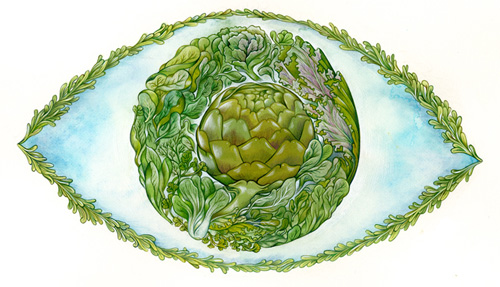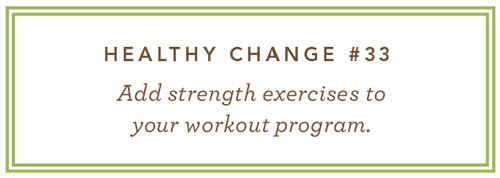Seeing Green

The quick answer: Spinach, kale, other dark greens, and eggs contain two antioxidants important to eye health: lutein and zeaxanthin.
_________________________________________________________________________________________________
The Rise and Fall of Diseases
Changes in society bring new diseases. In the rise of the Industrial Revolution, people left the farm and crowded into cities to work in factories. My ancestor Robert Hellewell was an example: In England’s first general census, taken in 1841, he and his wife Mary had left the villages of their birth for the textile mills in the city of Leeds. He was a machinist, she a loom tender.
It was spontaneous—cities weren’t designed, they just happened. Systems for delivering clean water and taking away sewage didn’t exist. Increasingly, the perishable foods of the farm were replaced with foods processed to extend shelf life. In times past, you ate what you or a neighbor could grow; now you could eat whatever was for sale, including a modern treat once reserved for kings: sugar. The body was used to scarcity, but it had few controls to protect against this new year-around bounty. The times were a changing and food traditions were tossed aside.
In crowded cities infectious diseases, once rare, became common. Children were the primary victims; in 1900 half the funerals in our largest East Coast cities were for children. Of the diseases, tuberculosis was the most frightening but epidemics like colera were scary too.
It was cholera that gave birth to a new science, epidemiology—the study of epidemics. A London doctor named John Snow observed how a cholera outbreak centered on a public well. He had the well shut down and the outbreak stopped. (The well's source was sewage-polluted water from the river Thames.) In retrospect, the infectious diseases were simple: one bacterium caused one disease.
Though simple, it took a century to control the infectious diseases and the solution was through public works: clean water, sewage systems, and street drains. By the middle of the 20th century mortality among children had declined and the rise of vaccines and antibiotics added a further measure of control.
A New Paradigm
Unfortunately, a new health threat arose—the chronic diseases. Epidemiology, the old paradigm, caused us to look in the wrong places for a solution to these modern diseases.
- First, they weren’t diseases of a single cause; they have multiple causes.
- Second, because of their complexity the cure is elusive. Now prevention would be the "cure" but society doesn't easily change its paradigms.
- Third, these diseases develop slowly, over decades, so in a lifetime of living it’s difficult to find causes hidden, like needles, in a haystack as big as society.
- Maybe there is a fourth issue: diet is a big part of these diseases and in a free society we can’t control what people eat, so observational studies—which use occasional “food frequency questionnaires”—are an ineffective tool.
The effect of chronic disease can be seen in one statistic, longevity. We imagine that longevity has greatly increased in the last century, and it has for children but not for adults. The life expectancy for a 65-year old in 1900 was 12 additional years, in 2000 it was 18 years—only a six-year improvement despite an enormous investment in health care.
A New Strategy
Though society moves at glacial speed, individuals can respond quickly, if they don't mind being different. The wise person understands that a new paradigm calls for a new strategy. If you read this blog and apply the Healthy Changes, you’ve on the leading edge. To use a quaint term from the past, you're a pioneer. People have different needs, but the new strategy for saving one's health looks something like this:
- Focus on prevention; let the scientists chase the elusive cure.
- Make many changes. It’s not one thing; the chronic diseases are multifactorial so you must change many risk factors.
- Focus on what you can change. Scientists are in love with genetics, it’s the new thing, but you’ve already chosen your parents.
- Start with diet. We eat 15-20 pounds of food a week plus we live in a toxic food environment. Over the years, unhealthy food is a giant source of toxins.
- Start early and be patient. These diseases develop over decades and though the body has remarkable healing powers if well fed, it takes time.
Lutein and Zeaxanthin
Vegetables (and fruits) contain hundreds of antioxidants from the carotenoid family. (Carotenoids get their name from carrots, but they come in other colors.) Dark green veggies are a key source of antioxidants. Two—lutein and zeaxanthin—found in spinach and other dark greens (and natural eggs, too) play a special role in eye health. Of all the carotenoids, only zeaxanthin and lutein are found in the retina. As these are fat-soluble nutrients, eating them with healthy fats aids absorption. There's hidden wisdom in the tradition of splashing olive oil on salads.
The diseases of the week are cataracts and age-related macular degeneration (AMD).
Macular degeneration: Zeaxanthin protects the retina against oxidative stress. The center of the retina, the macula, provides the sharp vision needed for reading, and is rich in leutin. Leutin protects the macula against harmful blue light. In 2007, a 6-year National Eye Institute study confirmed that lutein and zeaxanthin protect against AMD blindness. The study also found the omega-3 fats EPA and DHA protective. We discussed the role of these omega-3 fats in a prior post, “The Worst Food Mistake of the Last Century” and suggested they be included in every meal.
Lutein and zeaxanthin are traveling cousins; foods like spinach, kale, and eggs that contain one, contain the other. Science has not yet determined an optimum level for lutein and zeaxanthin in the diet. Until we know more, it’s important to eat a diet rich in whole foods, especially greens and other colored fruits and vegetables. These foods are also rich in beneficial vitamins, minerals, other antioxidants, fiber, and yet undiscovered nutrients which likely work together in a synergistic way.
What about lutein and zeaxanthin in pill form? While supplements provide certain nutrients, most studies do not find a benefit from eating supplements alone and adverse effects have been seen. A 2006 Cochrane Review of the AMD research did not find a protective role for supplements. So get your lutein, zeaxanthin, omega-3s and other nutrients in whole foods, unless a qualified doctor recommends otherwise.
Cataracts
Cataracts form from degraded protein buildup in the eye lens. There are many causes, though age is always a factor. Causes noted in the last post included cigarette smoke, excessive UV exposure, heavy alcohol consumption, and certain drugs. Photosensitizing drugs (steroids, antihistamines, birth control pills, tranquilizers, NSAIDS, and antidepressants) are a cataract risk factor if used long-term. Occupational exposure to radiation is another cause. Astronauts and airline pilots (cosmic radiation), and radiologists (X-rays and other ionizing radiation) have a high risk for cataract formation.
How about your kitchen microwave? There is no credible evidence, to my knowledge, showing increased cataract risk from kitchen microwaves. On the other hand, I find no serious studies of the subject. If there is an influence, it is likely small but should not be ignored. My personal conclusion is to limit microwave use to warming food (not cooking) and try not to stand with my face to the door waiting to eat (which in my impatience I have done many times).
Does cell phone radiation contribute to cataracts? Same answer, I think. We don’t really know but the influence is most likely small. Still, it's a good reason to text, as the phone isn’t near your head. Speaking of cell phones, there is a new iPhone app for checking cataracts in 3rd world countries. MIT researchers just announced a hand-held device they named Catra that attaches to an iPhone to scan your eye for cataracts. Termed “a radar for the human eye” it opens the door to an idea many would like: do-it-yourself eye care. Catra is still in beta stage but it's a way cool idea.
The Bottom Line
Because of the way research is funded, there is surprisingly little solid guidance on how we should protect our eyes. I know someone who was diagnosed with early-stage cataracts. The doctor made no recommendation for protective action and almost seemed pleased to have a new candidate for their cataract surgery business. Protecting vision is a little like the immune system—what’s good for the whole body is likely also good for the immune system . . . and your eyes. But for starters, eat a naturally colorful diet that includes antioxidants like lutein and zeaxanthin, and get plenty of exercise. Maintain a healthy weight and occasionally check your blood pressure and blood sugar levels. And try to find a doctor passionate about preventing eye diseases. In upcoming posts we’ll talk about the importance of getting enough sleep and managing the stresses in our lives.
Please comment on your experience with eye health. This is a subject too seldom discussed so lets share what we’ve learned.
 Wednesday, September 7, 2011 at 4:32PM | by
Wednesday, September 7, 2011 at 4:32PM | by  Skip Hellewell |
Skip Hellewell |  6 Comments | | in
6 Comments | | in  eye health,
eye health,  vegetables |
vegetables |  Email Article
Email Article 








